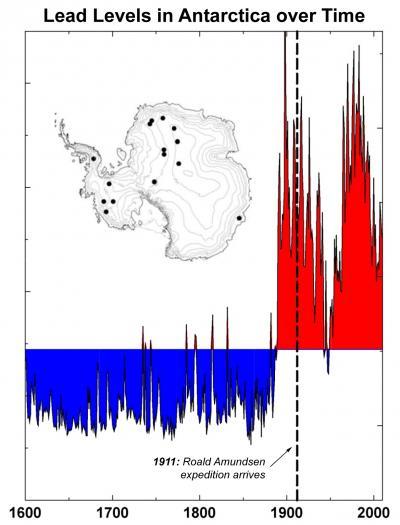Norwegian explorer Roald Amundsen reached the South Pole in 1911, but new research shows that industrial air pollution arrived long before any human.
Using data from 16 ice cores collected from widely spaced locations around the Antarctic continent, including the South Pole, a group led by Joe McConnell of the Desert Research Institute (DRI) in Reno, Nevada, created the most accurate and precise reconstruction to date of lead pollution over Earth's southernmost continent. The new record, described in an article published today in the online edition of the Nature Publishing Group's journal Scientific Reports, spans a 410-year period from 1600 to 2010.
"Our new record shows the dramatic impact of industrial activities such as smelting, mining and fossil fuel burning on even the most remote parts of the world," McConnell said.
"It is very clear that industrial lead contamination was pervasive throughout Antarctica by the late 19th century, more than two decades before the first explorers made it to the South Pole," he added. "The idea that Amundsen and Scott were traveling over snow that clearly was contaminated by lead from smelting and mining in Australia, and that lead pollution at that time was nearly as high as any time ever since, is surprising to say the least."
This study included ice cores collected as part of projects funded by the National Science Foundation. Additional ice cores were contributed to the study by international collaborators including the British Antarctic Survey, the Australian Antarctic Division and the Alfred Wegener Institute in Germany.

This graph shows composite ice core records of lead in Antarctica from 1600 to 2010. The areas shaded in blue and red indicate when lead values were below or above the 410-year average, respectively, highlighting the dramatic change before and after industrialization in the Southern Hemisphere.
(Photo Credit: Desert Research Institute)
"The ice cores obtained through international collaborations were critical to the success of this study in that they allowed us to develop records from parts of Antarctica not often visited by U.S.-based scientists," said co-author Tom Neumann of NASA's Goddard Space Flight Center in Greenbelt, Maryland, who participated in a Norway-U.S. traverse that collected several of the cores used in this study. "This included the Law Dome region of East Antarctica and a big section of East Antarctica visited by the Norwegian-United States Scientific Traverse of East Antarctica."
All measurements of lead and other chemicals used in this study were made using DRI's continuous ice core analytical system. Low background atmospheric concentrations, together with well-known and often distinct isotopic characteristics (variants of lead with different atomic weights) of industrial sources make lead an ideal tracer of industrial pollution.
"Lead is a toxic heavy metal with strong potential to harm ecosystems," said co-author Paul Vallelonga of the University of Copenhagen. "While concentrations measured in Antarctic ice cores are very low, the records show that atmospheric concentrations and deposition rates increased approximately six-fold in the late 1880s, coincident with the start of mining at Broken Hill in southern Australia and smelting at nearby Port Pirie."
The similar timing and magnitude of changes in lead deposition across Antarctica, as well as the characteristic isotopic signature of Broken Hill lead found throughout the continent, suggest that this single emission source in southern Australia was responsible for the introduction of lead pollution into Antarctica at the end of the 19th century and remains a significant source today, the authors report.
Data from the new ice core array illustrates that Antarctic lead concentrations reached a peak in 1900 and remained high until the late 1920s, with brief declines during the Great Depression and the end of World War II. Concentrations then increased rapidly until 1975 and remained elevated until the 1990s.
Concentrations across the Antarctic continent have since declined, but still are about four-fold higher than before industrialization, despite the phase out of leaded gasoline and other mitigation efforts in many countries in the Southern Hemisphere, the report states.
"Our measurements indicate that approximately 660 tonnes [1.5 million pounds] of industrial lead have been deposited on the snow-covered surface of Antarctic during the past 130 years," McConnell said. "While recent contamination levels are lower, clearly detectable industrial contamination of the Antarctic continent persists today, so we still have a ways to go."
Source: NASA/Goddard Space Flight Center